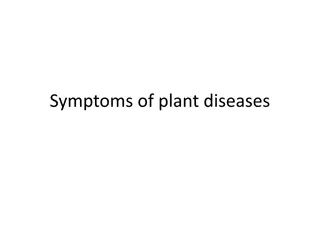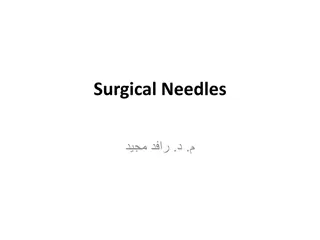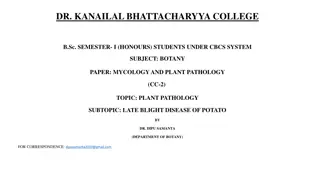Needle Blight Mycosphaerella Gibsonii: Symptoms, Host Plants, and Management
Needle blight caused by the fungal pathogen Mycosphaerella gibsonii is a serious disease affecting various species of Pinus trees. The disease, first recorded in Japan in 1913, primarily impacts seedlings and saplings, leading to significant infection rates and death rates under epidemic conditions. Symptoms include lesions on needles, stunted growth, and leaf loss. This article provides information on host plants, disease symptoms, identification, spread, transmission, and management strategies like conducting surveys for visual symptoms and using chemical controls in nurseries.
Download Presentation

Please find below an Image/Link to download the presentation.
The content on the website is provided AS IS for your information and personal use only. It may not be sold, licensed, or shared on other websites without obtaining consent from the author.If you encounter any issues during the download, it is possible that the publisher has removed the file from their server.
You are allowed to download the files provided on this website for personal or commercial use, subject to the condition that they are used lawfully. All files are the property of their respective owners.
The content on the website is provided AS IS for your information and personal use only. It may not be sold, licensed, or shared on other websites without obtaining consent from the author.
E N D
Presentation Transcript
Needle Blight Mycosphaerella gibsonii Photo: H. Hashimoto, Bugwood.org # 1949016
Needle Blight Fungal pathogen First recorded in Japan in 1913 Serious disease of exotic and native trees in Pinus spp. Mostly affects seedlings and saplings Under epidemic conditions, may cause 100% infection rates and 50-80% death rates Disease severity influenced by: Species infected, age of tree infected, environmental conditions Needle blight symptoms on Pinus thunbergii. Photo: H. Hashimoto, Bugwood.org # 1949016
Host Plants Numerous species of Pinus trees including: Rocky Mountain bristle cone pine shortleaf pine lodgepole pine slash pine ponderosa pine white pine loblolly pine Under laboratory conditions, other conifers are susceptible Resistance to the disease reported in a few Pinus spp.
Potential Distribution Risk Map (2011) Risk Potential High Low Map courtesy of www.nappfast.org accessed 11/12/2013
Disease Symptoms Appear within 2 to 5 weeks of infection on lower needles Lesions that are 5 10 mm long initially light, yellow- green bands; fade to gray-brown no reddish tint Dark fruiting bodies on lesions. Host loses leaves, has stunted growth, and may die Lesions on infected Pinus thunbergii needles. Photo: European and Mediterranean Plant Protection Organization, eppo.int
Identification Fungal species can be distinguished by examining conidia - asexual non-motile spores of a fungus. Conidia of Mycosphaerella sp. Photo: William Jacobi, Colorado State University, Bugwood.org, #5366775
Spread and Transmission Pathogen spreads on infected nursery stock Hyphae can overwinter in affected needles or as a latent infection on healthy-looking needles Spores dispersed by rain splashor overhead irrigation 2 to 3 days of moist, humid conditions required for fungal dispersal and infection
Monitoring and Management Monitoring conduct a survey for visual symptoms and collect blighted needles Chemical control in nurseries, use maneb (or mancozeb) or copper-based fungicides Cultural control all diseased seedlings should be removed and burned early in the season
Look-alike Species Dothistroma blight (Mycosphaerella pini) Note Needles infected by M. gibsonii do not have a reddish tint as with other pine diseases. Photos: (Left) Robert L. James, USDA Forest Service, Bugwood.org #1241609; (Right) Susan K. Hagle, USDA Forest Service, Bugwood.org #1241610 M. pini symptoms on Pinus ponderosa.
Look-alike Species Diplodia blight (Sphaeropsis sapinea) Note - Needles infected by M. gibsonii do not have a reddish tint as with other pine diseases. S. sapinea symptoms on Pinus ponderosa. Photos: (Left) Joseph O Brien, USDA Forest Service, Bugwood.org #5029014; (Right) Susan K. Hagle, USDA Forest Service, Bugwood.org #1241526
Look-alike Species Brown Spot Needle Blight (Mycosphaerella dearnsesii) M. dearnssii symptoms on Pinus sylvestris L.(Scots pine) M. dearnssii symptoms on Pinus palustris (longleaf pine) Photos: (Left) - David J. Moorhead, University of Georgia, Bugwood.org, #0908075; (Right) - Darroll D. Skilling, USDA Forest Service, Bugwood.org , #1949034
Look-alike Species Pine Needle Rust (Coleosporium asterum) C. Asterum symptoms on Pinus resinosa (red pine) Above: C. Asterum symptoms on red pine. Below: fruiting bodies (aecia) on pine host Photos: (Left) USDA Forest Service - North Central Research Station Archive, USDA Forest Service, Bugwood.org , #1406007; (Right top) Susan K. Hagle, USDA Forest Service, Bugwood.org #1241526; (Right bottom) - USDA Forest Service - North Central Research Station Archive, USDA Forest Service, Bugwood.org , #1406003
Look-alike Species Needle Cast (Ploioderma and Lophodermiumspp.) Lodgepole pine needle cast symptoms (above); Immature fruiting bodies of Ploioderma spp. on Pinas nigra Arnold (below) Ploioderma needle cast symptoms on Pinus virginiana (Virginia pine) Photos: (Left) David J. Moorhead, University of Georgia, Bugwood.org, #0485002; (Top Right) USDA Forest Service Archive, USDA Forest Service, Bugwood.org, #1241614; (Bottom right) - Sandra Jensen, Cornell University, Bugwood.org, #5492330
Look-alike Species Pitch Canker Disease (Fusarium circinatum) Slash pines showing resin on outside of stem Pitch canker symptoms on Pinus elliottii Englem (slash pine) Longleaf pine with pitch canker, note resin soaked wood & resin on stem Photos: (Left) Terry S. Price, Georgia Forestry Commission, Bugwood.org, #1247233; (Middle) Jason Smith, University of Florida; (Right) Tyler Dreaden, University of Florida
Authors Annika Minott Graduate Research Assistant, Doctor of Plant Medicine Program, University of Florida Smriti Bhotika, Ph.D. Postdoctoral Associate, Department of Entomology and Nematology, University of Florida
Editors Stephanie Stocks, M.S. Assistant-In, Extension Scientist, Department of Entomology and Nematology, University of Florida Matthew D. Smith, Ph.D. Associate, Department of Entomology and Nematology, University of Florida Postdoctoral
Reviewers Jeff Eickwort, B.S. Forest Biologist, Florida Department of Agriculture and Consumer Services, Florida Forest Service Jason Smith, Ph.D. School of Forest Resources and Conservation, University of Florida Aaron Palmateer, Ph.D. Associate Professor, Tropical Research and Education Center
Collaborating Agencies U.S. Department of Agriculture Animal and Plant Health Inspection Service (USDA-APHIS) Cooperative Agricultural Pest Survey Program (CAPS) Florida Department of Agriculture and Consumer Services (FDACS) National Plant Diagnostic Network (NPDN) Sentinel Plant Network (SPN) Protect U.S. University of Florida Institute of Food and Agricultural Sciences (UF-IFAS)
Educational Disclaimer and Citation This presentation can be used for educational purposes for NON-PROFIT workshops, trainings, etc. Citation: Minott A., Bhotika, S., Ph.D., 2014. Needle Blight, Mycosphaerella gibsonii, June 2014.
References Barnard, E. 1985. Republished 2008. Forest and Shade Tree Pests: Needle Casts of Pines. Florida Forest Service, Florida Department of Agriculture and Consumer Services. Accessed 1/23/2014 http://www.freshfromflorida.com/content/download/4612/29442/Needle%20Cast%20of %20Pines.pdf CAPS Report. 2010. Mycosphaerella gibsonii. Accessed 12/06/2013 - http://caps.ceris.purdue.edu/webfm_send/586 Diekmann, M., J.R. Sutherland, D.C. Nowell, F.J. Morales, and G. Allard, editors. 2002. FAO/IPGRI Technical Guidelines for the Safe Movement of Germplasm. No. 21. Pinus spp. Food and Agriculture Organization of the United Nations, Rome/International Plant Genetic Resources Institute, Rome. Accessed 12/06/2013 http://www.bioversityinternational.org/uploads/tx_news/Pinus_spp._828.pdf Dreaden, T., J. Smith. 2010. Reviewed 2013. Pitch Canker Disease of Pines. University of Florida, IFAS, Florida Cooperative Extension Service. Accessed 1/23/14 https://edis.ifas.ufl.edu/fr298#FIGURE 2
References EPPO Data Sheets on Quarantine Pests. Mycosphaerella gibsonii. CABI and EPPO European and Mediterranean Plant Protection Organization. Accessed 12/06/2013 http://www.eppo.int/QUARANTINE/fungi/Mycosphaerella_gibsonii/CERSPD_ds.pdf EPPO Data Sheets on Quarantine Pests. Mycosphaerella dearnsii and Mycosphaerella pini. CABI and EPPO European and Mediterranean Plant Protection Organization. Accessed 1/22/2014 http://www.eppo.int/QUARANTINE/fungi/Mycosphaerella_dearnessii/SCIRSP_ds.pdf University of Illinois Extension. 1999. Report on Plant Disease: Needle Blights and Needle Casts of Pines. University of Illinois at Urbana-Champaign, Department of Crop Sciences. Accessed 1/22/2014 http://web.aces.uiuc.edu/vista/pdf_pubs/624.PDF USDA Forest Service.Pine Needle Rust. Accessed 1/22/2014 http://www.na.fs.fed.us/spfo/pubs/misc/red%20pine%20pocket%20guide/pnr4.htm























